Hair health is something that not all of us pay attention to. We often use products that are not suitable for our scalp or subject it to invasive treatments, which in the long term can cause hair loss.
For some people, it is often worrying to see their brush full of hair after brushing, but hair loss is not always due to baldness or a disease. It is normal for both men and women to lose up to 150 hairs a day, as the scalp is in renewal and the strands complete the cycle of growth, degeneration, stagnation, fall, and post-fall.
“We have three types of hair on our body: terminal hair, which is what we have on our head; vellus hair, which is less thick and we can see it on our arms; and intermediate hair, located on the genitals and armpits, which does not grow very long. When we refer to hair loss, we associate it with terminal hair loss,” explains dermatologist Vilma García.
So, if daily hair loss is normal, it is common to question when we should be concerned. According to the specialist, hair loss is a warning sign when we lose more than 150 hairs a day, there is a receding hairline, and when the thickness decreases up to 50 percent of the rest, which causes the middle hairline on top of our head to look open like a Christmas tree.
In addition to paying attention to how many hairs we lose each day, it is also important to notice how they fall out. If a person has short hair, they may not notice when their hair falls out, unlike someone who has hair below the shoulder, but they will see how their hair thins or notice the holes that appear as it falls out.
Comparing photos from previous years helps determine if you have thinning hair. If you see that there are lighter areas on your head, i.e. no hair, then it is best to consult a dermatologist.
Diseases that cause hair loss
In some cases, hair loss can be caused by genetic, hormonal, or environmental factors. However, some diseases also cause alopecia, a term used to refer to hair loss.
“As dermatologists, we have to see if the loss follows a pattern, if it is a handful of hairs in which we count more than 150, if there is miniaturization of the hair, or if there are patches in which the loss occurs. The latter is alopecia areata,” says Maureen Barahona, dermatologist.
Alopecia can be classified into two types: non-scarring, which constitutes the vast majority of cases. Hair is lost, but the hair follicle that produces it is not damaged, so with proper treatment it is possible to recover the hair. Scarring occurs when the destruction of the hair follicle has been damaged by an inflammatory, infectious, or traumatic mechanism and hair loss is irreversible.
Non-scarring alopecias include:
- Androgenic alopecia: In men, it is seen in hair loss mainly in the frontal and parietal areas, which manifests itself in the progressive delay of the implantation line in front of the hair, commonly known as “receding hairline”, with later involvement in the crown region. In women, there are no areas of total baldness and there is no receding hairline.
- Alopecia Areata: This is distinguished by the appearance of round patches, similar to a quarter. Hair can grow back with treatment, as the hair follicles are not clogged.
- Diffuse alopecia: hair loss is severe, acute, or chronic, but is not localized to a specific area of the scalp. Hair loss occurs two to four months after the triggering factor. It can be seen after childbirth, serious illness, stress, or significant weight loss.
Scalp pathologies are other causes of hair loss, including dandruff, seborrhea, hives, and folliculitis.
In addition, diseases such as diabetes, hypothyroidism, nutritional deficiencies such as a lack of vitamin D, and immunological diseases such as lupus and antiphospholipid syndrome also cause hair loss. “Sleep disorders, stress, gastritis, irritable bowel syndrome, and lack of protein cause poor hair quality, which could be a trigger for hair loss,” says García.
Hair loss treatments
Regarding treatments, Barahona says that no miracle product will stop hair loss. The important thing is to verify the factors that predispose the cause. That is, specialists focus on what the patient needs, for example, stress management therapies, a better diet, vitamin compensation, etc.
How to care for your hair
Dermatologist Maureen Barahona shares some tips to prevent hair loss:
- If you have straight hair, comb it when it is dry. If you have wavy or curly hair, do it when it is damp.
- Avoid excessive use of hair dryers and hair straighteners.
- Dry your hair with a microfiber towel to create less friction.
- Avoid sleeping with your hair tied up.
- The pillowcase should be made of silk.
- Conditioner and styling cream are applied from mid-lengths to ends, not on the scalp.
- Avoid bleaching more than two shades apart, so that the bark does not suffer much damage.























+ There are no comments
Add yours